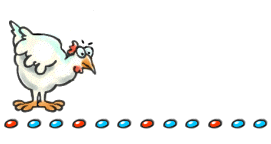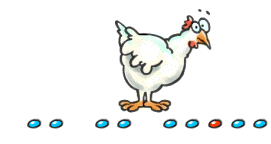First and oldest
application
The idea for this program came from one experiment
which was made in the beginning of the twenty century. The idea of this
experiment was to teach the hens to count. One biologist put in a row grains
but every second grain in the row was treated with a special chemical which
makes it not tasty.
 |
So the row was: one good grain, one bad grain,
and so on. The hen started to eat the grain but very soon it understood
that the second grain is not tasty and start to eat only the good ones.
I.e. the hen started to count: "one - two, one - two". After that the task
for the hen was made harder. One good grain and two bad ones. Then the
hen started to count "One, two, three. One, two, three." The result was
that some hens studded to count to four other to five (hens like people
have different intelligence). |
| The idea was to make the next step and after
making hens to count (to catch dependencies) to study computers to do the
same. The result was this simple program which can catch most dependencies
which the human being can catch. |
 |
Like example of a row which is easy for our program
is the Fibonachi
row. This is the row (1, 1, 2, 3, 5, 8, 13, and so on). To give this row
to the program you should first to code it in a row of zeros and ones.
The coded row can be the following: (0101 0110 1110 1111 10...) i.e. zero
like separator and ones which number give the next number from Fibonachi
row.
How this program works. As we said in a very
simple way. First it ask you to think for infinite row of zeroes and ones,
then you can give some beginning of your row (it can be the empty beginning
either). After that our programs look for the first Turing machine which
can generate this beginning and its prognoses is the next digit which this
Turing machine will generate. This mean that when our program catch your
dependence then it can guess the next numbers in the row but also it can
show you the rule which generates this row (the Turing machine).
Theoretically our program can guess all calculable rows
(with some restriction for effectiveness) but in practice the time for
this grows exponentially with the growth of the difficulty and for more
complicated rows it thinks practically infinitely. You will ask how intelligent
is this program. Well, the answer is: like a human being. The rows like
the Fibonachi row and like two on power N can be easily guessed by people
and by this program but more complicated rows practically cannot be guessed
by any of them.
You can download and try this
program. It is an old program and has DOS interface. It was written
on Turbo C somewhere between 1991 and 1993. It is one useless but anyway
amusing program.

